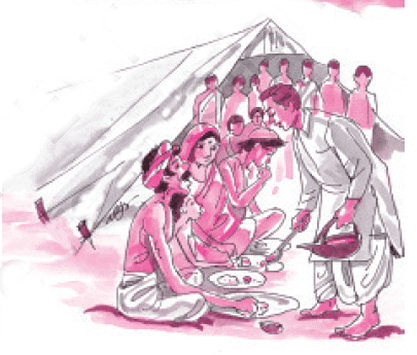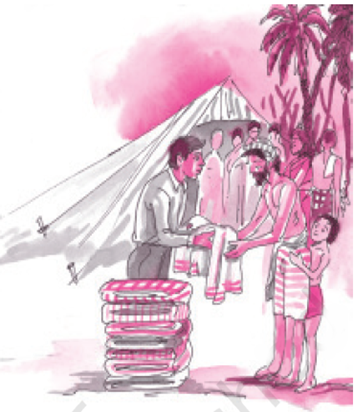Class 9 Moments Supplementary Reader Chapter 6 Question Answers - Weathering the Storm in Ersama
Q.1. Describe the destruction caused by the super cyclone as narrated in the story ‘Weathering the Storm in Ersama’.
Ans.
On 27th October 1999, Prashant went to meet one of his friends who lived in Ersama. The place was eighteen kilometres from his village.
In the evening, a super cyclone came. Winds beat against the houses with great fury. There was heavy and continuous rain. Houses and people were washed away in the flood. His friend’s house was made of bricks and cement. It was strong enough to survive the wind blowing at 350 km per hour.
The one uprooted tree fell on their house and damaged some part of its roof and walls. To escape the waters rising in the house, Prashant and his friend’s family took refuge on the roof. For the next two days, Prashant sat huddled with his friend’s family on the rooftop. They froze in cold and rain.
In the early morning, Prashant saw the destruction caused by the cyclone. There was a sheet of water everywhere. Only parts of cemented houses were still visible. All other houses had been washed away. Even huge trees had fallen. Bloated dead bodies of animals and human beings were floating everywhere.
Q.2. Describe how Prashant reached his village after the cyclone?
Ans.
The destruction caused by the cyclone and the waves of the ocean continued for the next thirty-six hours. Two days later, the rain ceased and the rainwater slowly began to recede.
Prashant was worried about his family. He took a long stick and started on the eighteen kilometers long and difficult journey to his village. There was water everywhere. He had to use his stick to locate the road. At places, it was waiting deep and the progress was slow. Sometimes, he lost the road and had to swim.
Prashant on his way to village
After some distance, he found two friends of his uncle. They decided to move ahead together. They had to push away many human bodies floating on the water. There were also carcasses of dogs, goats, and cattle. In every village they passed, they could barely see a house standing.
He feared that his family could not have survived the cyclone. At last, he reached his village Kalikuda. His heart sank. His house was gone. His family was nowhere. In order to look for his family, Prashant went to the Red Cross Shelter.
Fortunately, his family was alive. They were very glad to see Prashant. He came to know that eighty-six lives were lost in his village and all the ninety-six houses had been washed away.
Q.3. Describe how Prashant helped himself and others at the time of the natural calamity?
Ans.
The cyclone caused a lot of damage in Prashant’s village and surrounding areas. Prashant helped his own family and the others by following ways:
- He organized a group of youths. They pressurized the local merchant to give rice to the starving villagers. They burnt a fire and cooked the rice, although it was rotten; their next step was to clean the place of filth, dirt, urine, and floating dead bodies.
- They tended the wounds and fractures of many who had been injured. On the fifth day, a military helicopter dropped food. But it did not return. Prashant and others devised a plan to attract the attention of the helicopters.
- They deputed children to lie there with empty utensils on their stomachs. This was done to communicate to the helicopters that they were hungry. The scheme worked and the helicopters started dropping food regularly.
- The Prashant brought the orphaned children and made a shelter for them. He asked the woman to look after them. But he found that women and children were sinking deeper and deeper into their grief.
- A non-government organization had started a food for work program. Prashant persuaded them to join it. He engaged other volunteers to help widows start their lives again. The orphaned children were resettled in their own community.
Q.4. Prashant did not help his family members, but he helped the whole community during the cyclone. What is your opinion on this matter?
Ans.
On reaching his village, Prashant found deplorable conditions all around him. He had leadership qualities so he took the initiative to rehabilitate people. He made a team of young volunteers and cleaned urine, filth, vomit, and floating carcasses.
His team was fully dedicated to serving others. He persuaded grief-stricken women to look after children. In this way, he became a ray of hope for all.
Undoubtedly, Prashant is a good leader. He has all the qualities of a leader. He has a special quality of taking initiative. His vision is quite clear. He faces adverse circumstances courageously. He is a source of energy for others and has great motivational power.
I think that youth is power. This power can be used to assist society during natural disasters. Whatever job is assigned to the youth in such circumstances they perform their duty with full spirit.
Q.5. The widows and orphans of village Kalikuda remember Prashant’s help after the cyclone with gratitude. Explain how Prashant helped them in their darkest hour of grief.
Ans.
Prashant helped the people of village Kalikuda in the following ways:
- Providing emotional support: Prashant understood the emotional needs of the widows and orphans and provided them with a shoulder to lean on during their darkest hour of grief.
- Organizing relief efforts: Prashant took the initiative and organized groups of people to distribute food, water, and other essential supplies to those affected by the cyclone. He ensured that everyone received the necessary assistance, including the widows and orphans who may have been overlooked otherwise.
- Securing food and resources: Prashant and his team managed to secure rice for the people to eat and arranged for relief packages to be sent via helicopter. This provided much-needed sustenance and supplies to the people who were struggling to survive in the aftermath of the cyclone.
- Maintaining hygiene and sanitation: Prashant understood the importance of maintaining cleanliness in the shelter to prevent the spread of diseases. He led efforts to clean up the filth, vomit, urine, and floating carcasses to create a more hygienic environment for the survivors.
- Engaging the community: Prashant encouraged the people in the shelter to participate in various activities to keep their minds occupied and alleviate their grief.
Q.6. During natural calamities, women and children need more protection. Explain Prashant’s role in organizing relief measures for women and children during the storm in Ersama.
Ans.
During the natural calamity in Ersama, Prashant played a crucial role in organizing relief measures for women and children who needed more protection. He understood their vulnerability and took proactive steps to ensure their safety and well-being.
- Firstly, Prashant took on the responsibility of a leader and mobilized a group of young people and elders to help the victims. He showed great negotiating skills in convincing the merchants to provide rice for the affected people.
- Next, Prashant focused on maintaining cleanliness and hygiene in the shelter to prevent the spread of diseases. He organized a team of youth to clean the surroundings and tend to the wounded people, particularly women and children who might have been unable to care for themselves.
- Understanding the emotional impact of the disaster on the survivors, especially the women who had lost their families, Prashant persuaded women to look after the orphaned children.
- To further address the emotional well-being of the affected people, Prashant organized games and activities for the children to distract them from their loss and trauma. He also encouraged the women to participate in Food-for-work program, which helped them regain their confidence, self-esteem, and a sense of normalcy amidst the chaos.
Q.7. Do you think adversity or crises bring people closer? How? Explain with reference to the lesson ‘Weathering the Storm in Ersama’.
Ans.
Man is a social animal. Despite food and other common needs, he cannot live without the company and love of his near or dear ones. In adversity or crises, it is noticed that they come forward to help one another without any previous ill-feeling for one another.
Adversity or crisis brings people together. There is a bond of humanity. The victims of the cyclone in Erasama helped one another. They worked together during this resettlement. They took care of orphans and widows. Prashant managed to unite them and work for one another. Thus in the hour of grief, the people of the community joined hands under the leadership of Prashant. They came forward to help one another.
Prashant brought the survivors together and formed a youth task force. The youth took the charge and volunteered themselves for cleaning the shelters of filth, urine, and vomit.
Q.8. The future of a country depends upon the power of youth. Explain how Prashant organized the youth in Ersama to help the cyclone-affected people.
Ans.
Prashant played a crucial role in organizing the youth in Ersama to help the cyclone-affected people. Some of the steps he took include:
- Becoming the leader: Prashant took charge and assumed the responsibility of leading the village during the crisis.
- Ensuring food supply: He sent a delegation to the local merchants and successfully acquired the necessary rice quota for the people taking shelter in the shed.
- Organizing volunteers: Prashant formed a team of volunteers who helped clean the shelter, making it more habitable for the affected people.
- Establishing a youth task force: Realizing the need for more assistance, Prashant set up a youth task force to help with various tasks and responsibilities.
- Communicating with helicopters: The youth task force devised a creative way of communicating their needs to passing helicopters. They had children lie on the floor with empty utensils on their stomachs, signaling that they were hungry and needed food.
|
98 videos|532 docs|74 tests
|
FAQs on Class 9 Moments Supplementary Reader Chapter 6 Question Answers - Weathering the Storm in Ersama
| 1. What is the book "Weathering the Storm in Ersama" about? |  |
| 2. How did the people of Ersama prepare for the cyclone? |  |
| 3. What were the effects of the super cyclone on Ersama? |  |
| 4. How did Anuradha manage to survive the storm? |  |
| 5. What lessons can we learn from "Weathering the Storm in Ersama"? |  |































